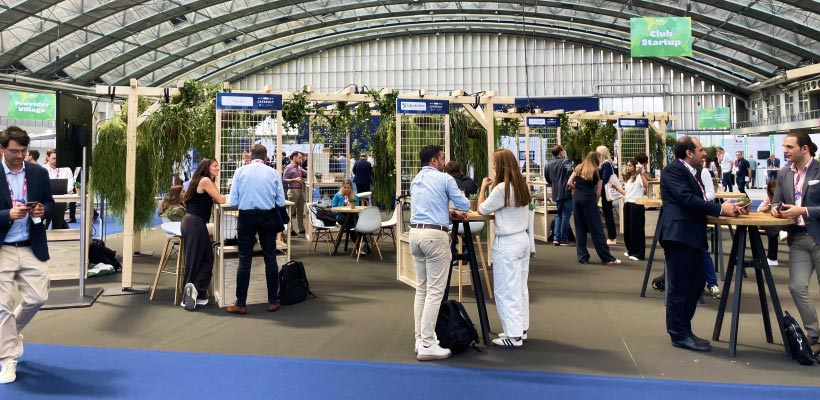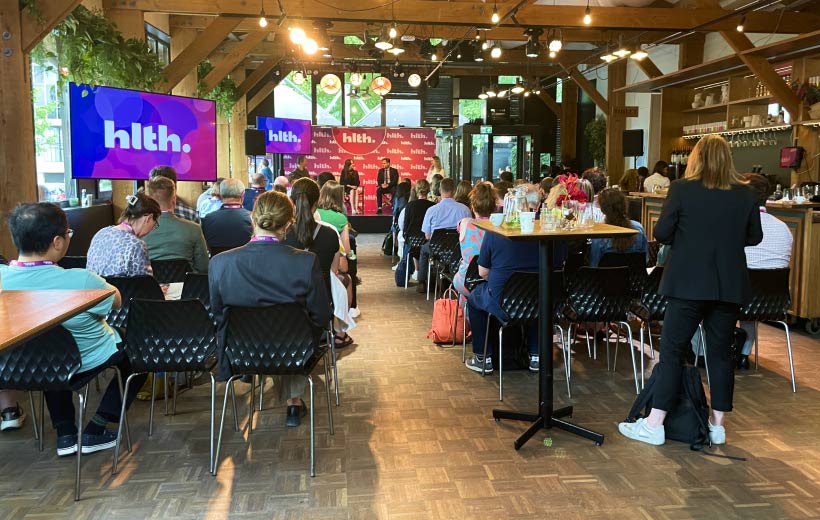HLTH Europe is by far the hottest HealthTech event of June, so there was no way Light IT Global’s team could miss it! If you didn’t make it to Amsterdam this year to take part in the conference, fear not! We’ve gathered all of the most interesting bits in this article.
Revolutionary Potential of Ambient AI
If you haven’t heard about ambient AI before, in a nutshell, it’s a kind of AI-based systems that seamlessly and continuously run in the background of everyday environments, analyzing the surroundings and the context to operate proactively without the need for direct user interactions. In the context of healthcare, some examples are passive patient monitoring systems (sensors in the room not attached to the human body), infection control systems, voice-activated clinical assistants, and ambient listening.

At HLTH, the topic of ambient listening was discussed during the panel “All ears: Ambient listening in healthcare”. The Global CMO of Microsoft, David Rhew, founder of Quadrivia, Ali Parsa, CDIO of SSM Health, Saad Chaudhry, and CDO of The Guthrie Clinic, Terri Couts, highlighted some of the benefits and challenges of this emerging tech trend.
The ability of ambient AI to record conversations between the provider and the patient, analyze it, and then come up with a list of relevant recommendations which the healthcare professional can quickly review and approve/tweak opens up so many ways for care improvement that it’s easy to understand why ambient AI is considered the next big thing in healthcare.
Unlike many HealthTech tools that require at least some kind of training to bring maximum value to the providers, ambient AI is extremely easy to use, as all the healthcare professional has to do is say what they’re thinking out loud, and AI will do the rest. As a result, doctors have more time as well as physical and mental resources to focus on direct interaction with the patient. Ambient AI has the potential to end a “keyboard-bound” era when the provider spends at least half of the patient’s visit staring at the screen, taking notes on the laptop.

But it’s not just more eye contact we’re talking about. Ambient AI can use the information retrieved from the conversation to generate documentation automatically, decrease the burnout rates among healthcare workers (which are skyrocketing by the way), and restructure the healthcare workflows to make them more effective.
So, what are the challenges if everything seems rosy on paper? There are a few. The participants of the panel mentioned accuracy, data privacy concerns, and consent. Just like any AI, ambient AI is not perfect and is prone to inconsistencies and errors, so the human review will still be necessary for all the recommendations and documentation generated by AI. The risk-averse nature and the general conservatism of the healthcare industry slow down the adoption speed despite the pretty low entry barrier for ambient AI. Still, seeing this technology introduced into the healthcare settings across the globe is only a matter of time.
Returning Attention to Women’s Health
Doesn’t it seem a bit ridiculous that in 2025, we still need to bring the spotlight to the importance of women’s health and closing the gender gap in healthcare? Shouldn’t this subject be well-researched and taken care of by now? Well, it is what it is, even in 2025, FemTech remains narrowly defined and overlooked by investors, which leads to an array of global negative consequences not only from healthcare but also from an economic view.

Several speakers at HLTH emphasized the market ripeness and the desperate need for safe, ethical, and, more importantly, diverse digital solutions focusing on women’s health. Fertility apps and platforms focusing on wellness rather than healthcare have been the poster child for women’s health far too long, and female entrepreneurs, activists, and public officials are determined to change that.
One of the ways in which this shift is guided is the redefinition of what FemTech is about. A comprehensive approach to introducing healthcare solutions that focus on aspects such as mental health, chronic pain management, disease prevention, and cardio-metabolic health can make a significant difference and deliver positive results relatively quickly. Women are not only more likely to visit a healthcare professional when experiencing any kind of symptoms, but they’re also more willing to take proactive measures to take care of their health. Yet, today they’re lacking tools that would facilitate self-support and early intervention.

Another urgent matter discussed during this year’s conference is the data bias. Issues like women's underrepresentation in clinical trials, misdiagnosis due to the fact that many conditions present differently in the female body, gender bias in AI models, and many others can no longer be overlooked.
Last but not least, the investors’ interest in FemTech remained extremely low during the last decade, but the situation is changing slowly but surely. The share of FemTech in the global digital health funding in the first quarter of 2025 is at 7.6%, which is promising considering the fact that in 2023 it was 6.2%.
HealthTech in Space Is Not a Fantasy Anymore
If Katy Perry can go to space, can’t we use our ability to travel beyond Earth for more noble and useful purposes? The answer is yes, we can, and many companies specializing in healthcare research and life science do that already.
The panel “Space health: The final frontier (for medical science)” shed light on how microgravity environments revolutionize drug discovery and development, disease prediction, and even health insurance.

Farmaceutical factories in space are capable of producing purer protein crystals, which results in for monoclonal antibodies. As the CEO of the UK-based company BioOrbit, Dr Katie King mentioned during the panel, the microgravity environments aid protein crystalization and allow receiving much more uniform crystals compared to those that can be produced on Earth. As a result, we’re able to receive more concentrated drug formulation for antibody drugs.
But it’s not like space is the only place where space health research and advancements can be held. Several bed rest and isolation studies are conducted under simulated microgravity conditions on Earth. The impact of such studies is truly global as they help address many existing healthcare challenges, like muscle loss and cardiac care for patients on long-term bed rest, cognitive decline, and immune system dysfunction.
New Generations Bring New Outlook on Healthcare
While the topic of generational divide in healthcare wasn’t one of the central themes during HLTH Europe 2025, it still remains extremely important as the time when Gen Z and Gen Alpha will make up the majority of the global workforce are closer than we think.

Luckily, even in 2025, we’re seeing some positive changes in the way people approach their health and wellness, actively utilizing technology to take the matter into their own hands in the best way possible. Managing Director of Strategic Health Solutions at Google for Health, Amy McDonough, emphasized that it’s the consumers who drive healthcare into the future. Ultimately, people’s willingness to utilize HealthTech, such as wearables, sensors, trackers, and apps, provides them with more tools to advocate for themselves and take better care of their physical and mental health. And this drive is even higher among digitally native generations — Gen Z and Gen Alpha.
At the same time, currently, there is a great imbalance in decision-making power as most of the healthcare and HealthTech companies in the world are led by Boomers, Gen X, and, at the very best, older Millennials. Gen Z, who are currently between the ages of 13-28, have almost no say in what future technology will be like. The takeaway? Stronger focus on younger generations is imperative as essentially we may be putting effort into designing future solutions that will not be future-proof.



